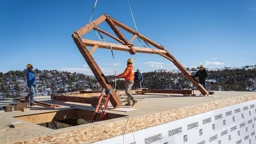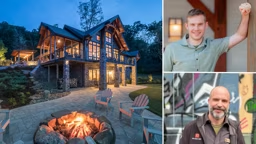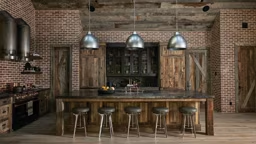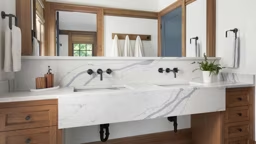
Timber homes continue to win converts with their craftsmanship, variety and superior energy efficiency. But despite their positive features, timber homes remain a small segment of the custom-home market. As a result, how to buy and build one of these homes remains a mystery to most people. The most important step toward figuring it all out: Understanding that buying and building a timber home is a process. During the planning phase, you’ll gather information to learn all that’s involved and the choices that are available to you. So, let’s get started.
1. Lay of the Land
Whether you’re hoping for a majestic view of the Grand Tetons or a wide-open Midwestern prairie, you need to know the lay of the land to plan your home right. A site map will explain the traits, benefits and challenges of your proposed building site. If the land is undeveloped, you also may need a topographical survey. Your township or county zoning office can supply you with information about easements, utilities and environmental considerations. The natural features of the landscape, along with the location of utilities, should be indicated on the site map.
One major component that will make or break your future home site is whether or not the property can pass a “perc test.” A perc test indicates the soil’s capability to absorb liquid over a specific period of time and determines the size and type of septic system you’ll need. If it doesn’t pass, you may not be able to build on it. You’ll also need a source of potable (drinkable) water. In rural areas, this typically means drilling a well. If you’re building closer to developed areas and are lucky enough to tap into public utilities, you can bypass these steps. Beyond the restrictions, it’s important to get acquainted with your land. Observing the way light and shadow change during the day, as well as the views you’ll have during the varying seasons, will enable you to determine the best position and orientation of your home.
See also 13 Design Ideas for a Cozy Timber Home
2. Money Matters
Before you even think about who’ll build your dream timber home on that perfect plot, you’ll need to know how much you can afford. If you plan to borrow money to finance your home, talk with a lender about the ins and out of construction loans. By reviewing your financial data, a lender can pre-qualify you, as well as explain how funds are dispersed during the course of construction and how that loan is converted to a mortgage once the house is complete. It’s a good idea to meet with at least one builder who’s familiar with the costs of building quality homes in the area where your house will be located, because building expenses vary from region to region.
3. Style & Species
Timber homes may have timeless appeal, but today’s designs are far from staid, running the gamut from traditional and classic to rustic or contemporary — and sometimes a mixture of these. Once you settle on a look, you’ll want to decide what kind of wood to use. Wood species vary in color and characteristics (for example, knots versus clear-grain) and play a huge part in the way your home looks and lives. The chart on page 16 shows a few of the more popular species and their attributes, but you’re not limited to these alone. Ask each timber provider you’re considering for information on the types of wood the company works with. Here are a few of the basic choices:
Green Wood
Green timbers are fresh from the forest. They have a high moisture content (30 percent or more), making them easy for timber framers to craft, since tools cut through them like butter. Green timbers also have the advantage of being the most economical option, since they’re less expensive than other varieties that require additional handling and preparation. The downfall to green wood is that what you see is not necessarily what you get. These timbers have a lot of drying to do — and all of it will be done after they’re crafted into your home. As it dries, green wood will check (crack) or twist as it reaches a new equilibrium with its environment. Fortunately, this checking process shouldn’t affect the structural integrity of your home.
Standing Dead Timber
Standing dead timbers are trees that were killed by insect infestation, fire or other means, causing them to dry out while still standing in the forest. Before you balk at the thought of building with bug-ridden trees, rest assured that once the tree is dead, the critters, without a food source, have moved on. With its low moisture content, this type of wood is more stable and less prone to checking or twisting than green timber. Standing dead timber does cost more, though, because it’s less plentiful.
Air- or Kiln-Dried
To reduce the amount of movement of the frame as it dries, some companies use air- or kiln-dried beams. Large kilns bake the timbers over several weeks, reducing the moisture content to around 18 to 20 percent. Air-dried timbers are left in log yards for two to three years to reach similar moisture content. In either case, you’ll pay more for a dried timber than you would for green wood because of this additional investment in time and resources.
Reclaimed Wood
If you’re looking for wood with a rich history, consider reclaimed timbers harvested from carefully dismantled, centuries-old factories, barns, bridges and houses. Some companies even have discovered huge old-growth trees no longer found in forests by dredging rivers and lakes near the sites of sawmills of yesteryear. Because these large posts and beams have been around so long, the moisture-content percentage is often in the single digits or low teens, making them extremely hard and stable. But because it’s more difficult to obtain and process these reclaimed timbers, most companies charge a premium for this product. No matter what type of wood you choose, be aware that price can vary dramatically. Because wood is a commodity, a host of variables influence its price. If you have your heart set on a particular type of timber but find it to be outside your budget, discuss strategies (e.g., cutting square footage or trimming your finishing materials budget) with your producer.
See also A French Country Montana Timber Home
4. Try Hybrid
So far we’ve touched on the elements of timber home construction in its purest form. But increasingly, today’s timber-home buyers are combining conventional construction with timber elements. These “hybrid” designs typically reserve timbers for public areas (great room, foyer, kitchen, dining area) and use conventional (stick) framing in less frequently viewed areas. Another growing design trend is to mix and match different wood species and profiles of timbers, causing many log home producers to expand their product offerings to include timber construction.
5. The Company You Keep
Before you can live in the timber home of your dreams, you need someone to craft and build it. This process can seem overwhelming, but it doesn’t have to be. The key is to understand what you’re looking for in a timber company before you start shopping for one. Then once you’ve targeted a number of companies that appeal to you, you can whittle down the list to only those that most closely match your goals. For instance, do you need a company that offers turn-key construction (that is, the home is delivered to you completely finished, and all you have to do is turn the key to enter)?
Or do you have a local builder in mind, and all you need from the timber company is the wood? Do you want your frame to be handcrafted (using traditional hand tools) or milled (using state-of-the-art, computer-controlled machines)? Or are you looking for purely decorative post-and-beam accents? Also consider the type of wood a producer works with. The majority of timber companies offer freshly harvested wood, but some craft their homes from recycled or salvaged wood.
If you already have your heart set on a particular species or age of wood, these criteria can help you narrow your decision. In addition to offering different techniques and wood types, timber-home companies also differ in the size of their operations. A larger company has the resources to offer a wide range of service and depth of talent, often employing specialists in architecture, engineering and construction. In a smaller company, you’re more likely to work directly with the owner, who may even be cutting your timbers with his own hands. The company you’ll choose depends on the type of relationship you want to have with your representative.
Once you narrow the field, request information, plansbooks, catalogs or videos from the companies that interest you. This material should answer many important questions, explain each company’s business philosophy and reflect its commitment to quality. You’ll find even more information on their web sites. Many will post photos of both completed homes and jobs in progress to give you a comprehensive look at their building techniques.
See also Timber Frame Cabin in Idaho Lake Pend Oreille
Wood Species
Douglas Fir
Heartwood Colors: Orange-brown to deep reddish brown, or sometimes yellowish
Western Red Cedar
Heartwood Colors: Medium to dark coffee brown
Eastern Hemlock
Heartwood Colors: Wood buff or pale brown, sometimes with a faint reddish hue
Red Oak
Heartwood Colors: Light reddish brown, often with a pinkish tinge
Eastern White Pine
Heartwood Colors: Creamy white to light brown, often with a reddish tinge











